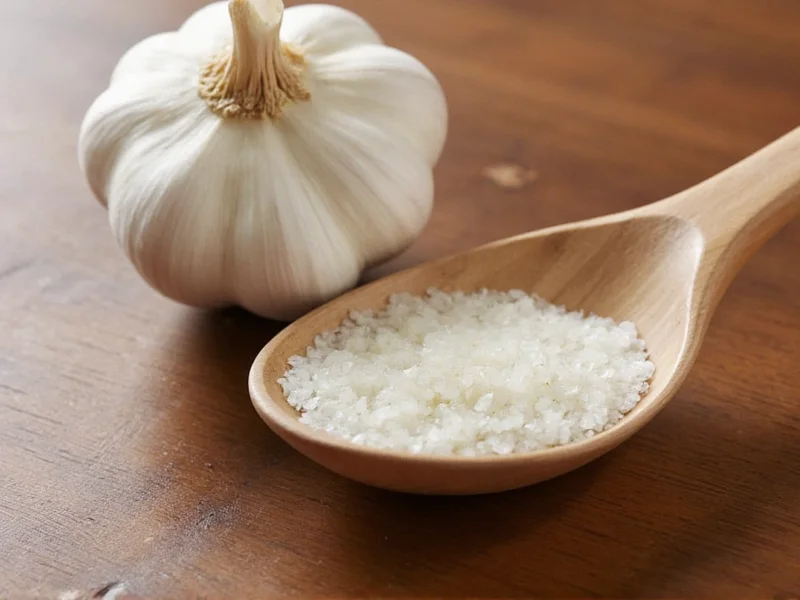Yes, garlic salt contains sodium. Garlic salt is typically made from a mixture of dried garlic powder and table salt (sodium chloride), with salt comprising about 60-75% of the blend. A 1/4 teaspoon serving of garlic salt contains approximately 200-300mg of sodium, making it unsuitable for low-sodium diets without careful portion control.
Understanding the sodium content in your seasonings is crucial for maintaining a heart-healthy diet. Many people turn to garlic salt seeking flavor without realizing it often contains even more sodium by volume than regular table salt due to its fine texture and concentrated form.
What Exactly Is Garlic Salt?
Garlic salt is a common seasoning blend consisting primarily of two ingredients:
- Dried garlic powder (typically 25-40%)
- Table salt/sodium chloride (typically 60-75%)
Some commercial varieties also include anti-caking agents like calcium silicate or sodium silicoaluminate to prevent clumping. Despite its name suggesting a garlic-focused product, salt actually dominates the composition by weight.
Garlic Salt Sodium Content Compared to Other Seasonings
When evaluating sodium content in garlic salt versus other seasonings, the differences are significant. The table below shows sodium measurements for standard 1/4 teaspoon servings:
| Seasoning | Serving Size | Sodium Content | Sodium as % of Daily Value* |
|---|---|---|---|
| Garlic Salt | 1/4 teaspoon | 240-300mg | 10-13% |
| Table Salt | 1/4 teaspoon | 590mg | 25% |
| Garlic Powder | 1/4 teaspoon | 1-2mg | <1% |
| Low-Sodium Garlic Salt | 1/4 teaspoon | 70-100mg | 3-4% |
*Based on 2,300mg daily sodium recommendation for healthy adults
Why Garlic Salt's Sodium Content Matters for Health
Understanding the health implications of garlic salt sodium is important for anyone monitoring their sodium intake. The American Heart Association recommends no more than 2,300mg of sodium daily, with an ideal limit of 1,500mg for most adults, especially those with hypertension.
Many people mistakenly believe garlic salt is a healthier alternative to regular salt. In reality, because garlic salt is less dense than pure salt, you might actually consume more sodium when using it to achieve the same level of saltiness. This phenomenon makes garlic salt sodium comparison essential for health-conscious cooking.
Reading Nutrition Labels for Garlic Salt Products
When purchasing garlic salt, always check the nutrition facts panel. Look for:
- Serving size (often smaller than you might use)
- Total sodium content per serving
- Percentage of Daily Value for sodium
- Additional ingredients like anti-caking agents
Be aware that "garlic salt" and "garlic seasoning" are not the same. Some products labeled as "garlic seasoning" may contain little to no salt, making them better options for those reducing sodium.
Low-Sodium Alternatives to Garlic Salt
If you're looking for low sodium garlic seasoning alternatives, consider these options:
Garlic Powder
Pure garlic powder contains negligible sodium (1-2mg per 1/4 teaspoon) while providing robust garlic flavor. Use it as a direct substitute, though you'll need to add separate salt if desired.
Homemade Garlic Salt Substitute
Create your own blend with:
- 3 parts garlic powder
- 1 part potassium chloride (salt substitute)
- Optional: onion powder, parsley, or other herbs
Citrus-Garlic Infusions
Combine fresh minced garlic with lemon or lime zest for a sodium-free flavor boost that works well in many recipes traditionally calling for garlic salt.
Practical Tips for Using Garlic Salt Mindfully
If you enjoy garlic salt but need to watch your sodium intake, try these strategies:
- Measure precisely instead of free-pouring
- Use half the recommended amount and supplement with garlic powder
- Add garlic salt at the end of cooking rather than during
- Pair with potassium-rich foods like tomatoes or potatoes to help balance sodium effects
Remember that how much sodium is in garlic salt varies by brand, so always check labels if sodium content is a health concern for you.
When Garlic Salt Might Be Appropriate
Despite its sodium content, garlic salt serves a purpose in certain cooking applications:
- When precise salt measurement is difficult (like sprinkling on finished dishes)
- In recipes where both garlic and salt flavors are essential
- For people without sodium restrictions who want convenience
The key is understanding your personal health needs and using garlic salt accordingly.











 浙公网安备
33010002000092号
浙公网安备
33010002000092号 浙B2-20120091-4
浙B2-20120091-4